Handsome Victor Varconi (1891–1976) was a highly successful matinee idol of the Hungarian-Austrian and German silent cinema in the 1910s and early 1920s. Later he was the first Hungarian actor to become a Hollywood star until the sound film completely altered the course of his career.

Italian postcard by C. Chierichetti, Milano. Photo: Grandi Films, Roma. Publicity still for the Italian-German silent film Gli ultimi giorni di Pompeii/The Last Days of Pompeii (Amleto Palermi, Carmine Gallone, 1926), starring Victor Varconi as Glaucus, on the photo he is training at the gymnasium. The film was one of the many adaptations of the novel The Last Days of Pompeii (1834) by Edward George Bulwer-Lytton. Sets were by Vittorio Cafiero, costumes by Duilio Cambellotti.

Italian postcard by C. Chierichetti, Milano, no. 8. Photo: Grandi Films, Roma. Publicity still for the Italian-German silent film Gli ultimi giorni di Pompeii/The Last Days of Pompeii (Amleto Palermi, Carmine Gallone, 1926), starring Victor Varconi as Glaucus.
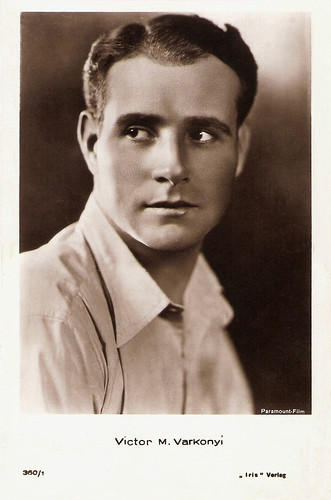
Austrian postcard by Iris-Verlag, no. 360/1. Photo: Paramount-Film.

Austrian postcard by Iris Verlag, no. 5062. Photo: Cecil B. de Mille-Studio. Publicity still for The King of Kings (Cecil B. de Mille, 1927).
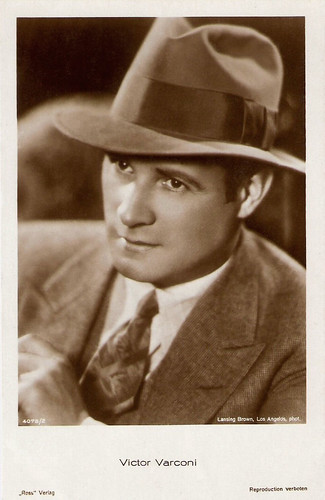
German postcard by Ross Verlag, no. 4075/2, 1929-1930. Photo: Lansing Brown, Los Angeles.
Victor Varconi was born Mihály Várkonyi in Kisvárda, Austria-Hungary (now Hungary) in 1891. He was born into a farming family on the Hungarian/Romanian border. He attended classes at Budapest's commercial college and at the dramatic school.
The young good-looking actor thrived for a time on the Transylvanian stage, where he played leads in such productions as Liliom at the Hungarian National Theatre in Budapest. His rising popularity as a matinee idol led to film roles, and he made his debut in Sárga csikó/Son of the Pusta (Félix Vanyl, 1913).
Other of his silent Hungarian films were Bánk Bán (Mihály Kertész aka Michael Curtiz, 1914) based on the play by József Katona, Mágia/Magic (Sándor Korda aka Alexander Korda, 1917), Szent Péter esernyöje/St. Peter's Umbrella (Alexander Korda, 1917) and Fehér rózsa/White Rose (Alexander Korda, 1919) starring Maria Corda, the director’s wife. Unfortunately nearly all these early films got lost.
After World War I, under the Horthy regime, Korda and many other film makers fled to Vienna, and Varconi followed them. He changed his marquee name to the more internationally friendly Michael Várkonyi and branched out into German and Austrian films. He showed impressive performances in Aus den Tiefen der Großstadt/ From the depths of the big city (Fred Sauer, 1920) and Nachtbesuch in der Northernbank/Night visit in the Northernbank (Karl Grune, 1921).
Then followed such films as Arme Violetta/Camille (Paul H. Stein, 1921) a silent version of La Traviata starring Pola Negri, Herren der Meere/Masters of the Sea (Alexander Korda, 1922), Versunkene Welten/Sunk worlds (Siegfried Philippi, 1922) with Ria Jende, and Namenlos/Nameless (Michael Curtiz, 1923) with Mary Kid.
A huge success was the biblical epic Sodom und Gomorrha/Queen of Sin (Michael Curtiz, 1922) with Lucy Doraine. IMDb reviewer Nora Nettlerash writes about his performance in this film: “with his devilish good looks he doesn't really need to act here, and with his commanding presence he makes a great angel of the Lord”.
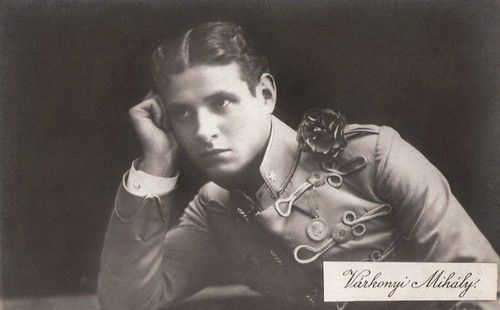
Hungarian postcard by B.J., Budapest.
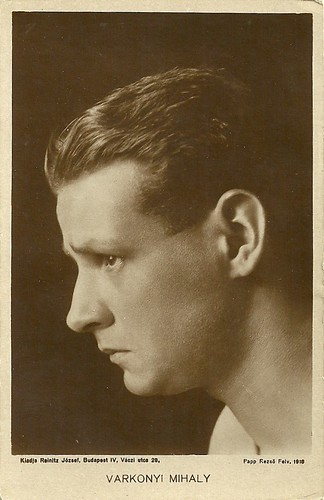
Hungarian postcard by Kiadja Reinitz Joszef, Budapest. Photo: Papp Reszo Felv., 1918.
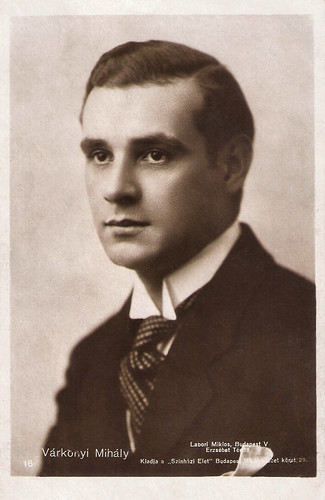
Hungarian postcard by Shinhazi Elet, Budapest, no. 16. Photo: Labori Miklos, Budapest.
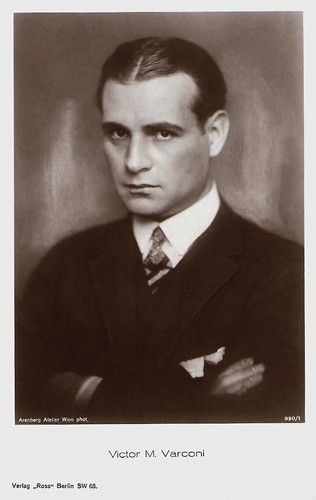
German postcard by Ross Verlag, no. 990/1, 1925-1926. Photo: Arenberg Atelier, Wien (Vienna).
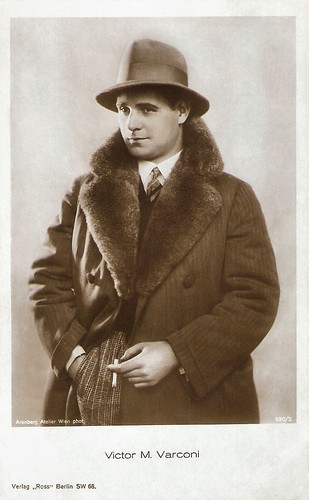
German postcard by Ross Verlag, no. 990/2, 1925-1926. Photo: Arenberg Atelier, Wien.
In 1924, because of the ever-shifting political climate of Europe, Michael Várkonyi moved to America to try his luck in Hollywood. First he played a supporting part in Poisoned Paradise (Louis J. Gasnier, 1924) starring It-girl Clara Bow.
Then he was signed by Cecil B. DeMille's company on his exceptional performance in Sodom und Gomorrha (1922). DeMille cast him as a wealthy American tin factory manager in Triumph (Cecil B. DeMille, 1924) opposite established star Leatrice Joy. He was billed now as Victor Varconi.
For DeMille's company, the smoothly handsome Varconi then played in the comedy Changing Husbands (Frank Urson, 1924) again opposite Leatrice Joy, had a character role as a bookkeeper in the afterworld in Feet of Clay (Cecil B. DeMille, 1924), later he was a Russian prince in The Volga Boatman (Cecil B. DeMille, 1926) starring William Boyd, and finally, a disgruntled Pontius Pilate in the biblical epic The King of Kings (Cecil B. DeMille, 1929).
Temporarily he returned to Europe. In Germany he reunited with director Alexander Korda and his wife Maria Corda for the comedy-drama Der Tänzer meiner Frau/Dance Fever (Alexander Korda, 1925). With Corda he also acted in the two Italian productions L'uomo piu allegro di Vienna/The happiest man in Vienna (Amleto Palermi, 1926) and the lavish spectacle Gli ultimi giorni di Pompeii/The Last Days of Pompeii (Carmine Gallone, Amleto Palermi, 1926) starring Italian diva Rina De Liguoro.
Back in Hollywood, the elegant and impeccably mannered Varconi went on to share the screen with some of the loveliest and talented ladies of silent Hollywood, including Agnes Ayres, Marie Prevost, and Jetta Goudal.
Notable is his portrayal of cuckolded husband Amos opposite Phyllis Haver's wild jazz-loving and boozing Roxie Hart in the silent Chicago (Frank Urson, 1927). His last major silent role was that of Lord Horatio Nelson in The Divine Lady (Frank Lloyd, 1929) co-starring Oscar-nominated Corinne Griffith as Lady Emma Hamilton.
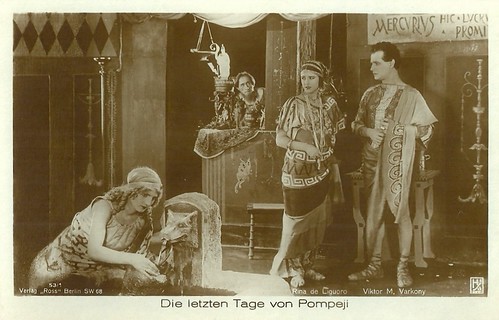
German postcard by Ross Verlag, no. 53/1. Photo: Hisa Film. Publicity still for the Italian silent epic Gi ultimi giorni di Pompei (Carmine Gallone, Amleto Palermi, 1926). Glaucus (Victor Varconi) and the rich Julia (Lia Maris, not Rina De Liguoro as this card pretends) meet on the streets of Pompeii, so the blind flower girl Nydia (Maria Corda) hears Glaucus is back in town. Set designer Vittorio Cafiero copied various original artefacts from Pompeii for this films, such as here the small burner held up by satyrs in the shop.
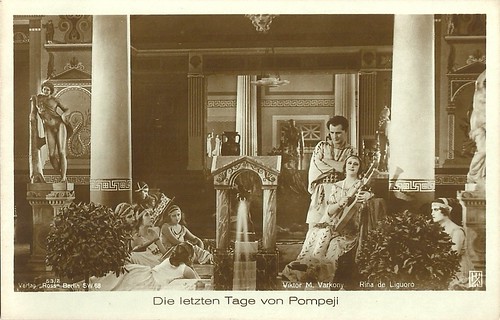
German postcard by Ross Verlag, no. 53/2. Photo: Hisa Film. Publicity still for the Italian silent epic Gi ultimi giorni di Pompei (Carmine Gallone, Amleto Palermi, 1926).
Glaucus (Victor Varconi) listens to beautiful and rich Greek Ione (Rina De Liguoro) playing the harp. The statue left was copied from an original Roman one.
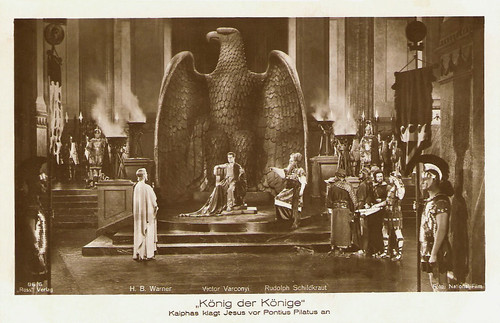
German postcard by Ross Verlag, no. 86/6. Photo: National-Film. Publicity still for King of Kings (Cecil B. De Mille, 1927) with Victor Varconi, H.B. Warner and Rudolph Schildkraut. Caption: Caiphas accuses Jesus before Pontius Pilate.
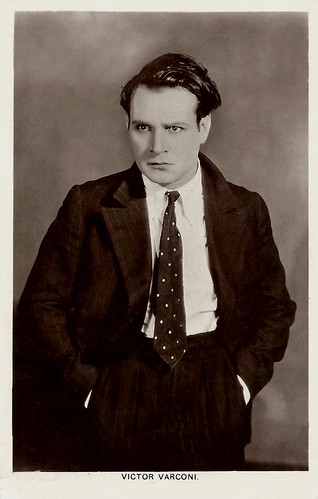
British postcard in the Picturegoer Series no. 338, London.
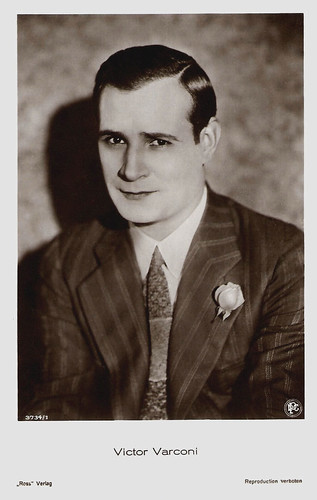
German postcard by Ross Verlag, no. 3734/1, 1928-1929. Photo: DPC.
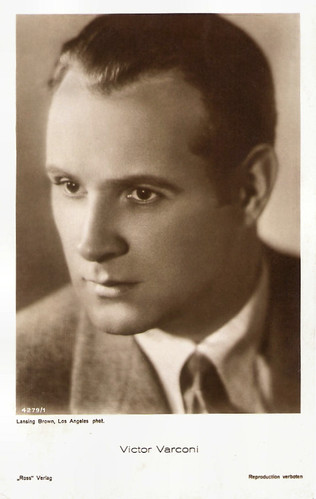
German postcard by Ross Verlag, no. 4279/1, 1929-1930. Photo: Lansing Brown, Los Angeles.
At the peak of his career as a romantic leading man, Victor Varconi had to face transition from the silent movies to the talkies. It completely altered the course of his career. He had a nice decent voice for sound film but his accent was noticeably thick. He no longer did become offers for leading parts.
Temporarily he worked in European silent films, such as the Polish Kult ciala/The Cult of the Body (Michal Waszynski, 1930) and the German Mein Herz gehört Dir.../My heart belongs to you (Max Reichmann, 1930) with Camilla Horn.
Back in Hollywood, he regressed slightly to suave ethnic character roles, such as in the Charlie Chan mystery The Black Camel (Hamilton MacFadden, 1931) starring Warner Oland. He often played foreign or royal dignitaries, European adventurers or roguish gigolos. He also starred in English-language versions of Anglo-German co-productions, such as Der Rebell/The Rebel (Luis Trenker, Edwin H. Knopf, 1933) starring Luis Trenker.
The forced move to character roles probably added years to his Hollywood life. During World War II Hollywood utilised his talents playing nefarious Axis commanders in spy intrigue and war dramas. In The Hitler Gang (John Farrow, 1944), he was quite skillful portraying Nazi Deputy Rudolf Hess. Varconi also appeared in many of his old boss Cecil DeMille's sound epics such as The Plainsman (Cecil B. DeMille, 1936) (as Indian chief Painted Horse), Reap the Wild Wind (Cecil B. DeMille, 1942) starring Ray Milland, Unconquered (1947, Cecil B. DeMille) with Gary Cooper, and Samson and Delilah (Cecil B. DeMille, 1949) starring Hedy Lamarr.
After 1949 Varconi scaled down his workload. He also worked on the New York City stage and wrote for radio. Among his Shakespearean theatre endeavours were roles in Hamlet, Romeo and Juliet, Antony and Cleopatra and Richard III. He also moved occasionally into TV in the 1950s.
Varconi did another film part in the Sci-Fi movie The Man Who Turned to Stone (László Kardos, 1957) starring Victor Jory. The plot was about a group of 18th-century scientists, who have remained young after all these centuries by using electricity to suck the life out of young women. After a supporting part in another Sci-Fi thriller, The Atomic Submarine (Spencer Gordon Bennet, 1960), he retired.
Victor Varconi had appeared in 120 films. He published his memoirs It's Not Enough to Be Hungarian, just before his death. In 1976, Victor Varconi died from a heart attack in Santa Barbara, California, at the age of 85. He was married twice. His second wife was stage actress Anna Aranyosy.
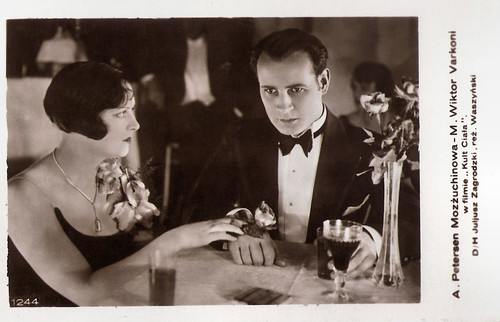
Polish postcard, no. 1244. Photo: publicity still for Kult ciala/The cult of the body (Michal Waszynski, 1930) with Agnes Petersen.
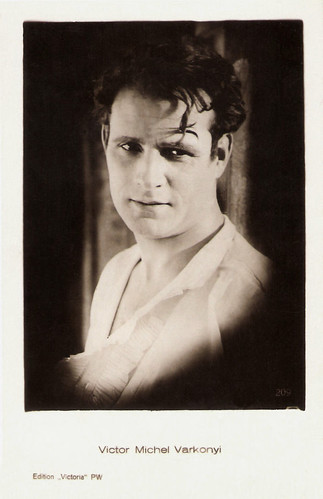
Polish postcard by Edition Victoria PW, no. 209.
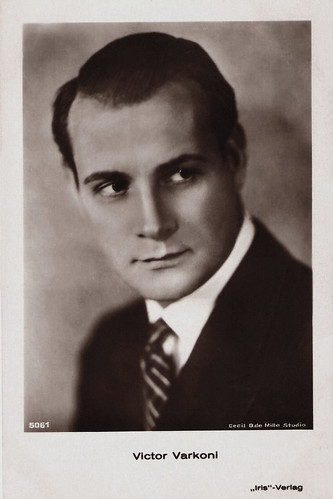
Austrian postcard by Iris Verlag, no. 5061, 1929-1930. Photo: Cecil B. DeMille Studio.
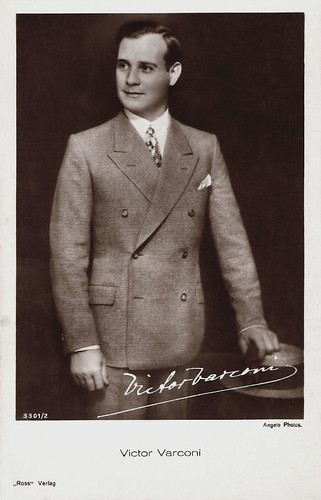
German postcard by Ross Verlag, no. 3301/2, 1928-1929. Photo: Angelo Photos.
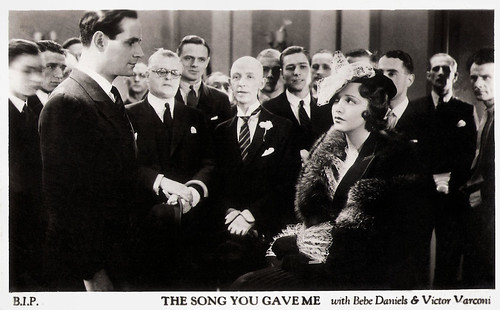
British postcard. Photo: B. I. P. Publicity still for The Song You Gave Me (Paul L. Stein, 1933) with Bebe Daniels.
Sources: Hal Erickson (AllMovie), Thomas Staedeli (Cyranos), Gary Brumburgh (IMDb), Wikipedia and IMDb.

Italian postcard by C. Chierichetti, Milano. Photo: Grandi Films, Roma. Publicity still for the Italian-German silent film Gli ultimi giorni di Pompeii/The Last Days of Pompeii (Amleto Palermi, Carmine Gallone, 1926), starring Victor Varconi as Glaucus, on the photo he is training at the gymnasium. The film was one of the many adaptations of the novel The Last Days of Pompeii (1834) by Edward George Bulwer-Lytton. Sets were by Vittorio Cafiero, costumes by Duilio Cambellotti.

Italian postcard by C. Chierichetti, Milano, no. 8. Photo: Grandi Films, Roma. Publicity still for the Italian-German silent film Gli ultimi giorni di Pompeii/The Last Days of Pompeii (Amleto Palermi, Carmine Gallone, 1926), starring Victor Varconi as Glaucus.

Austrian postcard by Iris-Verlag, no. 360/1. Photo: Paramount-Film.

Austrian postcard by Iris Verlag, no. 5062. Photo: Cecil B. de Mille-Studio. Publicity still for The King of Kings (Cecil B. de Mille, 1927).

German postcard by Ross Verlag, no. 4075/2, 1929-1930. Photo: Lansing Brown, Los Angeles.
Devilish Good Looks
Victor Varconi was born Mihály Várkonyi in Kisvárda, Austria-Hungary (now Hungary) in 1891. He was born into a farming family on the Hungarian/Romanian border. He attended classes at Budapest's commercial college and at the dramatic school.
The young good-looking actor thrived for a time on the Transylvanian stage, where he played leads in such productions as Liliom at the Hungarian National Theatre in Budapest. His rising popularity as a matinee idol led to film roles, and he made his debut in Sárga csikó/Son of the Pusta (Félix Vanyl, 1913).
Other of his silent Hungarian films were Bánk Bán (Mihály Kertész aka Michael Curtiz, 1914) based on the play by József Katona, Mágia/Magic (Sándor Korda aka Alexander Korda, 1917), Szent Péter esernyöje/St. Peter's Umbrella (Alexander Korda, 1917) and Fehér rózsa/White Rose (Alexander Korda, 1919) starring Maria Corda, the director’s wife. Unfortunately nearly all these early films got lost.
After World War I, under the Horthy regime, Korda and many other film makers fled to Vienna, and Varconi followed them. He changed his marquee name to the more internationally friendly Michael Várkonyi and branched out into German and Austrian films. He showed impressive performances in Aus den Tiefen der Großstadt/ From the depths of the big city (Fred Sauer, 1920) and Nachtbesuch in der Northernbank/Night visit in the Northernbank (Karl Grune, 1921).
Then followed such films as Arme Violetta/Camille (Paul H. Stein, 1921) a silent version of La Traviata starring Pola Negri, Herren der Meere/Masters of the Sea (Alexander Korda, 1922), Versunkene Welten/Sunk worlds (Siegfried Philippi, 1922) with Ria Jende, and Namenlos/Nameless (Michael Curtiz, 1923) with Mary Kid.
A huge success was the biblical epic Sodom und Gomorrha/Queen of Sin (Michael Curtiz, 1922) with Lucy Doraine. IMDb reviewer Nora Nettlerash writes about his performance in this film: “with his devilish good looks he doesn't really need to act here, and with his commanding presence he makes a great angel of the Lord”.

Hungarian postcard by B.J., Budapest.

Hungarian postcard by Kiadja Reinitz Joszef, Budapest. Photo: Papp Reszo Felv., 1918.

Hungarian postcard by Shinhazi Elet, Budapest, no. 16. Photo: Labori Miklos, Budapest.

German postcard by Ross Verlag, no. 990/1, 1925-1926. Photo: Arenberg Atelier, Wien (Vienna).

German postcard by Ross Verlag, no. 990/2, 1925-1926. Photo: Arenberg Atelier, Wien.
Trying His Luck in Hollywood
In 1924, because of the ever-shifting political climate of Europe, Michael Várkonyi moved to America to try his luck in Hollywood. First he played a supporting part in Poisoned Paradise (Louis J. Gasnier, 1924) starring It-girl Clara Bow.
Then he was signed by Cecil B. DeMille's company on his exceptional performance in Sodom und Gomorrha (1922). DeMille cast him as a wealthy American tin factory manager in Triumph (Cecil B. DeMille, 1924) opposite established star Leatrice Joy. He was billed now as Victor Varconi.
For DeMille's company, the smoothly handsome Varconi then played in the comedy Changing Husbands (Frank Urson, 1924) again opposite Leatrice Joy, had a character role as a bookkeeper in the afterworld in Feet of Clay (Cecil B. DeMille, 1924), later he was a Russian prince in The Volga Boatman (Cecil B. DeMille, 1926) starring William Boyd, and finally, a disgruntled Pontius Pilate in the biblical epic The King of Kings (Cecil B. DeMille, 1929).
Temporarily he returned to Europe. In Germany he reunited with director Alexander Korda and his wife Maria Corda for the comedy-drama Der Tänzer meiner Frau/Dance Fever (Alexander Korda, 1925). With Corda he also acted in the two Italian productions L'uomo piu allegro di Vienna/The happiest man in Vienna (Amleto Palermi, 1926) and the lavish spectacle Gli ultimi giorni di Pompeii/The Last Days of Pompeii (Carmine Gallone, Amleto Palermi, 1926) starring Italian diva Rina De Liguoro.
Back in Hollywood, the elegant and impeccably mannered Varconi went on to share the screen with some of the loveliest and talented ladies of silent Hollywood, including Agnes Ayres, Marie Prevost, and Jetta Goudal.
Notable is his portrayal of cuckolded husband Amos opposite Phyllis Haver's wild jazz-loving and boozing Roxie Hart in the silent Chicago (Frank Urson, 1927). His last major silent role was that of Lord Horatio Nelson in The Divine Lady (Frank Lloyd, 1929) co-starring Oscar-nominated Corinne Griffith as Lady Emma Hamilton.

German postcard by Ross Verlag, no. 53/1. Photo: Hisa Film. Publicity still for the Italian silent epic Gi ultimi giorni di Pompei (Carmine Gallone, Amleto Palermi, 1926). Glaucus (Victor Varconi) and the rich Julia (Lia Maris, not Rina De Liguoro as this card pretends) meet on the streets of Pompeii, so the blind flower girl Nydia (Maria Corda) hears Glaucus is back in town. Set designer Vittorio Cafiero copied various original artefacts from Pompeii for this films, such as here the small burner held up by satyrs in the shop.

German postcard by Ross Verlag, no. 53/2. Photo: Hisa Film. Publicity still for the Italian silent epic Gi ultimi giorni di Pompei (Carmine Gallone, Amleto Palermi, 1926).
Glaucus (Victor Varconi) listens to beautiful and rich Greek Ione (Rina De Liguoro) playing the harp. The statue left was copied from an original Roman one.

German postcard by Ross Verlag, no. 86/6. Photo: National-Film. Publicity still for King of Kings (Cecil B. De Mille, 1927) with Victor Varconi, H.B. Warner and Rudolph Schildkraut. Caption: Caiphas accuses Jesus before Pontius Pilate.

British postcard in the Picturegoer Series no. 338, London.

German postcard by Ross Verlag, no. 3734/1, 1928-1929. Photo: DPC.

German postcard by Ross Verlag, no. 4279/1, 1929-1930. Photo: Lansing Brown, Los Angeles.
Transition to the Talkies
At the peak of his career as a romantic leading man, Victor Varconi had to face transition from the silent movies to the talkies. It completely altered the course of his career. He had a nice decent voice for sound film but his accent was noticeably thick. He no longer did become offers for leading parts.
Temporarily he worked in European silent films, such as the Polish Kult ciala/The Cult of the Body (Michal Waszynski, 1930) and the German Mein Herz gehört Dir.../My heart belongs to you (Max Reichmann, 1930) with Camilla Horn.
Back in Hollywood, he regressed slightly to suave ethnic character roles, such as in the Charlie Chan mystery The Black Camel (Hamilton MacFadden, 1931) starring Warner Oland. He often played foreign or royal dignitaries, European adventurers or roguish gigolos. He also starred in English-language versions of Anglo-German co-productions, such as Der Rebell/The Rebel (Luis Trenker, Edwin H. Knopf, 1933) starring Luis Trenker.
The forced move to character roles probably added years to his Hollywood life. During World War II Hollywood utilised his talents playing nefarious Axis commanders in spy intrigue and war dramas. In The Hitler Gang (John Farrow, 1944), he was quite skillful portraying Nazi Deputy Rudolf Hess. Varconi also appeared in many of his old boss Cecil DeMille's sound epics such as The Plainsman (Cecil B. DeMille, 1936) (as Indian chief Painted Horse), Reap the Wild Wind (Cecil B. DeMille, 1942) starring Ray Milland, Unconquered (1947, Cecil B. DeMille) with Gary Cooper, and Samson and Delilah (Cecil B. DeMille, 1949) starring Hedy Lamarr.
After 1949 Varconi scaled down his workload. He also worked on the New York City stage and wrote for radio. Among his Shakespearean theatre endeavours were roles in Hamlet, Romeo and Juliet, Antony and Cleopatra and Richard III. He also moved occasionally into TV in the 1950s.
Varconi did another film part in the Sci-Fi movie The Man Who Turned to Stone (László Kardos, 1957) starring Victor Jory. The plot was about a group of 18th-century scientists, who have remained young after all these centuries by using electricity to suck the life out of young women. After a supporting part in another Sci-Fi thriller, The Atomic Submarine (Spencer Gordon Bennet, 1960), he retired.
Victor Varconi had appeared in 120 films. He published his memoirs It's Not Enough to Be Hungarian, just before his death. In 1976, Victor Varconi died from a heart attack in Santa Barbara, California, at the age of 85. He was married twice. His second wife was stage actress Anna Aranyosy.

Polish postcard, no. 1244. Photo: publicity still for Kult ciala/The cult of the body (Michal Waszynski, 1930) with Agnes Petersen.

Polish postcard by Edition Victoria PW, no. 209.

Austrian postcard by Iris Verlag, no. 5061, 1929-1930. Photo: Cecil B. DeMille Studio.

German postcard by Ross Verlag, no. 3301/2, 1928-1929. Photo: Angelo Photos.

British postcard. Photo: B. I. P. Publicity still for The Song You Gave Me (Paul L. Stein, 1933) with Bebe Daniels.
Sources: Hal Erickson (AllMovie), Thomas Staedeli (Cyranos), Gary Brumburgh (IMDb), Wikipedia and IMDb.
No comments:
Post a Comment